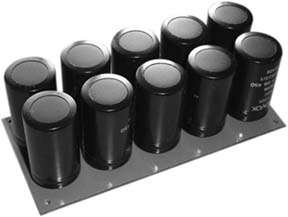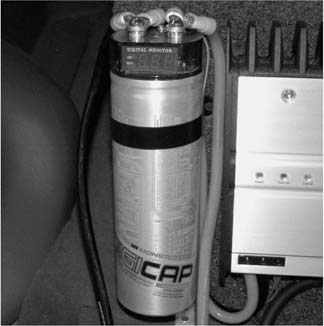Hack8.Use a Huge Capacitor to Sustain Power
Hack 8. Use a Huge Capacitor to Sustain Power
A large capacitor is often used to maintain bass amplifier response, and can address other problems as wellincluding voltage sags when the car is started. One of the many goals of aftermarket car audio systems is to create a reverberation that exceeds the boundary of the car, shaking other nearby cars and buildings. Car audio enthusiasts have been using 1-farad capacitors for years to make sure their cars go Boom! Boom! without brownouts or voltage sags. Bass response is the ability of the subwoofer to reproduce the low-frequency bass sounds in music with fidelity. One of the problems with subwoofers is that they need a lot of electrical energy to move the large speaker to reproduce the low-frequency bass sound waves. When the bass beat kicks hard, the speaker should instantly slam in responsebut often, the car's battery and electrical system can't put out enough power to ensure an instant response. I can explain this with another water analogy. Sometimes in houses with old plumbing, you lose water pressure in the shower whenever someone flushes the toilet or turns on the washing machine. Plenty of water is coming to the house via the mains; that's not the problem. The problem is that the plumbing can't maintain the pressure when too many demands are made on it. 1.9.1. Understanding CapacitorsCapacitors are one of the solutions to the problem of sagging voltage (electrical pressure). Capacitors are devices that store up electricity, like a temporary battery (think "capacity"). One of the uses of a capacitor is to help keep voltage at a constant level. Returning to the water pressure problem, imagine you had an extra device hooked to your plumbing, which I'll totally randomly call a capacitor. This extra device consists of a reservoir that holds perhaps 30 gallons of water. Whenever someone makes too many demands on the water system, the capacitor steps in and supplies the extra water. So, if you're taking a shower, and then somebody flushes the toilet and washes their hands, the capacitor has enough water to keep the pipes full for a little while and keep the pressure up. If, however, someone turns on the washing machine and someone else starts watering the lawn, the reservoir will probably run dry after a while, and the capacitor won't be able to maintain a comfortable shower pressure for the duration. With apologies to both the plumbing and electrical professions, this is roughly how an electrical capacitor works. Normally, the car is putting out upwards of 13V (remember, "12V" is just what it's called; the battery actually runs higher). When the bass amplifier demands massive current, the voltage of a normal electrical system might "sag" to 12 or 11 volts. If the car was driving at night, you might actually see the headlights dimming to the beat. With a large capacitor installed, however, the vehicle maintains the 13V that the battery is putting out. Since the beats are of short duration, the capacitor keeps the voltage up; the battery or engine puts out the current, and the audio system effectively delivers a "block-rocking beat." 1.9.2. Car PC Capacitor UseSustaining audio output is not the only benefit of using a capacitor. Of interest to in-car computing is the capacitor's ability to maintain voltage when, for instance, you're starting the car. When a car is started, for a few seconds the vehicle pulls almost all the battery power for cranking the engine. During this time, devices that are connected to the car battery have to endure a voltage that drops to much lower than 12Vpossibly even 7V or lower, depending on the state of the battery. If the car starts right up the voltage can come back up, but it's often too late for the car computer that began to boot when you first turned the key and then died when you started cranking. With a large capacitor and a good battery, it's possible that your computer can survive car-starting without a reboot. But that isn't the primary purpose of a fat capacitor, and buying an appropriate power supply that lets your computer survive engine cranking [Hack #45] is cheaper. Probably. Capacitors come in several shapes and sizes. The most recognizable are the little black cans you see on a motherboard. Whenever you see a small cluster of capacitors like the one in Figure 1-17 rising up from a computer motherboard, they are often near a power source, keeping the voltage constant. You see them a lot in power supplies as well. Capacitors are rated in farads, and the small capacitors inside electronics are in the microfarad range. You can think of farads as mega-gallons of electrons. Audio capacitors like the one in Figure 1-18, in comparison, are huge. They can be a foot long and as thick around as a small fire extinguisher. They come in 1-farad (1F) or higher capacities. Even though this sounds like a small number, it's not. Farads are just big units. The capacitor enhances the battery and is installed in parallel with the battery. Usually, the capacitor is installed near the audio equipment it is supporting (i.e., in the trunk) and near the power distribution block or amplifiers. Figure 1-17. Several microfarad capacitors (courtesy of Chris Gare) Figure 1-18. A 1-farad capacitor The 12V line from the battery (red/switched or yellow/unswitched) goes to the + side of the capacitor, and the ground (usually black) wire from the battery ground goes to theside of the capacitor. 1F capacitors for audio use come with their own mounting brackets and many of them are designed to look cool. They're easy to install and are essential for maintaining voltage levels in demanding car electrical systems. |
- Chapter II Information Search on the Internet: A Causal Model
- Chapter IV How Consumers Think About Interactive Aspects of Web Advertising
- Chapter XII Web Design and E-Commerce
- Chapter XIII Shopping Agent Web Sites: A Comparative Shopping Environment
- Chapter XIV Product Catalog and Shopping Cart Effective Design